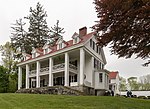Great Appalachian Valley
Appalachian MountainsEast TennesseeEastern United StatesGeography of AppalachiaGeography of the Lehigh Valley ... and 16 more
History of United States expansionismLandforms of New HampshireLandforms of South CarolinaRegions of PennsylvaniaRegions of VirginiaRegions of the United StatesValleys of AlabamaValleys of Georgia (U.S. state)Valleys of MarylandValleys of New JerseyValleys of New York (state)Valleys of PennsylvaniaValleys of TennesseeValleys of VirginiaValleys of the United StatesWestern Maryland

The Great Appalachian Valley, also called The Great Valley or Great Valley Region, is one of the major landform features of eastern North America. It is a gigantic trough, including a chain of valley lowlands, and the central feature of the Appalachian Mountains system. The trough stretches about 1,200 miles (1,900 km) from Quebec in the north to Alabama in the south and has been an important north–south route of travel since prehistoric times.
Excerpt from the Wikipedia article Great Appalachian Valley (License: CC BY-SA 3.0, Authors, Images).Great Appalachian Valley
Hott Lane,
Geographical coordinates (GPS) Address Nearby Places Show on map
Geographical coordinates (GPS)
| Latitude | Longitude |
|---|---|
| N 39.5 ° | E -77.833333333333 ° |
Address
Hott Lane
Hott Lane
Maryland, United States
Open on Google Maps





